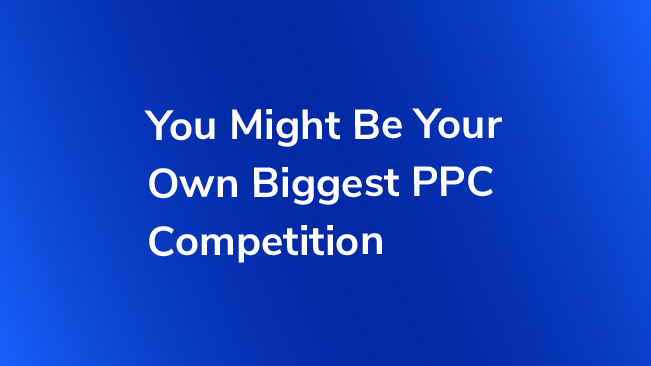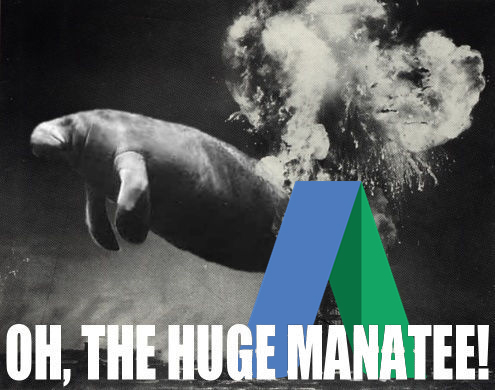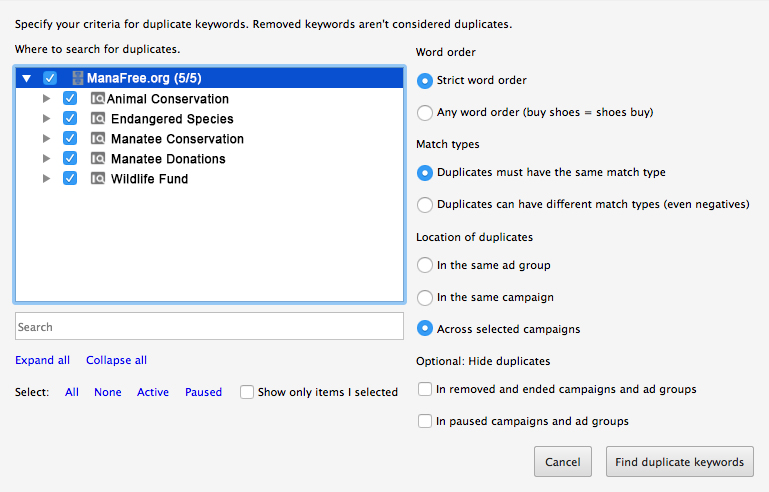You Might Be Your Own Biggest PPC Competition

Paid search competition comes in many forms. The competition is usually what we would expect – those other advertisers that are acting in the same commercial arena vying for the attention of consumer. Paid search competition has an interesting twist because your competitors can also include advertisers in completely different markets bidding on keywords similar to your own. In other words, you are competing with ALL advertisers that appear in an auction regardless of whether or not your actually participate in the same market sector.
These are the obvious examples, but paid search is rife with nuances that often go unseen until we start to peel back the layers in order to gain an understanding of how the whole system works. For example, did you know that there is another form of PPC competition that might be hiding right under your nose?
It lives in your own account.
That’s right… You might be your own biggest AdWords competitor. This comes in the form of internal keyword competition. Internal keyword competition?!
GASP! The horror of it all!

What is Internal Keyword Competition?
Internal keyword competition occurs when you have two or more “duplicate keywords” that share identical targeting in your Google AdWords account. Duplicate keywords that compete against each other directly share the same exact syntax and match type – it is quite literally a copy of a keyword. Identical targeting means that the duplicate keywords share the same geography, language, time, device, and/or audience settings.
These phenomena occur most often when the same keywords appear in multiple campaigns but can also occur when identical keywords are found in two or more different ad groups within the same campaign.
Because both keywords are technically eligible to serve in any and all instances in which they are present (so long as status is approved and eligible), AdWords must choose only one keyword to enter the auction. You cannot have two or more keywords enter the same auction, so the system must decide which instance to utilize upon serving up the ad impression. The keyword that AdWords chooses to trigger will be the keyword resulting in the greatest calculated Ad Rank. See more about how Google AdWords chooses to trigger your keywords.
What Does That Mean for Your Performance?
Increased CPCs
Unfortunately, internal keyword competition usually leads to increased CPCs because you are competing – bidding – against yourself to achieve the highest ad rank possible. If you have two identical keywords with identical targeting they will share a quality score. Furthermore, if the only differentiating factor between these keywords is the max CPC bid, AdWords will choose to serve the keyword with the higher bid because it will result in the higher calculated ad rank.
Assume the keywords below are present in two different campaigns that share identical targeting settings:
Keyword |
Max CPC bid |
Quality score |
Ad Rank |
Ad Served? |
| [manatee protection group] | $1.00 | 7/10 | 7 | ⨂ |
| [manatee protection group] | $2.00 | 7/10 | 14 | ✓ |
As we can see, the keyword with the higher Ad Rank is served. What truly sets the keywords apart at auction-time is the bid. In this instance the $1.00 max CPC bid would usually be enough for the ad to enter the auction but the advertiser is creating her own internal competition because another keyword with a higher max CPC bid is present in the account. That second keyword, the one with the higher resulting Ad Rank, will be selected during these moments and will ultimately drives costs unnecessarily higher for that select search term.
Poor Experience & Mixed Messaging
Internal keyword competition also creates issues when messaging variants are introduced. There are strategic shortcomings in these instances because advertisers lose control of which ads are served to potential customers resulting in poor user experience and convoluted messaging.
Let’s review an example:
Again, assume the identical keywords below are present in two different campaigns or ad groups. This time the keywords share an identical bid and it is the landing page varies between the two terms.
Keyword |
Landing Page URL |
Quality score |
Ad Rank |
Ad Served? |
| [save the manatee] | www.manafree.org/donate | 7/10 | 14 | ⨂ |
| [save the manatee] | www.manafree.org/save-the-manatee | 10/10 | 20 | ✓ |
Again, the keyword with the higher Ad Rank is selected. This time, it is the resulting quality score that determines the outcome because the keywords have identical bids ($2 in this instance).
Perhaps the advertiser’s strategy is to drive traffic to the donations page for their annual “end of year giving” season. To drive these donations that are willing to sacrifice some quality for the purpose of generating awareness of their cause. Since the ad driving users to www.manafree.org/save-the-manatee was not intended to be served for this query you can see how this might present some strategic issues.
The lesson here is that if you don’t really seize control over which keyword-landing page instances take precedence you can skew your strategy. There is a clear flaw in the campaign configuration, as we can see above, that causes the strategy to fall flat. Users will not see the right message and future performance analysis will be difficult to dissect.
Warning for Multi-account Advertisers
These phenomena don’t just happen in individual accounts either. For those advertisers managing complex digital marketing projects that span multiple AdWords accounts, you should be on red alert. This undoubtedly will occur as different product or service marketing teams vie for valuable traffic.
Unfortunately, there is a finite amount of traffic based on the relevant terms associated with the brand. These different teams within the same organization usually step on each other’s toes as they seek to win the “most lucrative” AdWords auctions. If everyone is targeting the same keywords throughout the organization, then everyone is driving up everyone else’s CPCs. This traffic is often even of the branded variety!
Examples
- Colleges and universities promoting various schools, branch campuses, and online degrees frequently fall victim to this nuisance behavior as various initiatives take precedence over others and separate marketing teams seek to win the eyes of prospective students.
- Enterprise organizations providing layers of unique services and solutions should build comprehensive messaging that speaks to all solutions rather than assuming users will search for complex naming conventions that are used internally at the organization.
- Ecommerce companies working with various distributors that also bid on their product terms should be generally aware of this behavior and try to grasp whether it is better to be a strong competitor in these auctions or to allow their distributors to win the bid and facilitate the sale – there are major ROI analyses to look into here. Consider a product that is sold on your website and also at the local Target.
- Non-profit organizations managing both standard and Google Grants accounts should be aware of how budget is distributed among the keywords in their very different accounts which can be limited by a capped max CPC bid.
Diagnose & Resolve
Now that you better understand what causes internal keyword competition, you can prevent it. But how do you find if it is already happening in your account?
Luckily there’s a quick way to diagnose potentially harmful instances of internal competition within your account with the help of Google AdWords Editor and the “Find Duplicate Keywords” tool. You can find the tool in Google AdWords Editor under the “Tools” menu selection.

The tool allows you to select which campaigns and/or ad groups to evaluate for keyword duplication. After opening the tool select the campaigns or ad groups that you would like to evaluate. To find true instances of internal keyword competition, you should ensure that campaigns and ad groups share targeting settings such as geography, device, and those outlined above.
Set the word order to “strict word order,” set the match types to “duplicates must have the same match type,” and set location to “across select campaigns” to find absolute duplicates.

Once you click the “Find duplicate keywords” button, the tool outputs a filtered result that allows you to remove or pause duplicates at your whim. You might even go the extra mile to ensure that your negative keyword implementation is working to prevent future instances of internal keyword competition from occurring by excluding the specific search term in the campaigns are ad groups which you intend to no longer serve for those specific queries..
This is a great time- and cost- saving practice to get into the habit of adding to your management routine. All account managers should do this at least once to review the status of their account and to determine if there are any unforeseen account issues to be resolved.
Give it a shot to see if internal competition is affecting your account and bottom-line.
Internal Competition & Separate Accounts
If you control the account for your company and create the campaigns, there are tools like the one above that will help you identify and fix those issues. However, if you’re in one of the scenarios where your department may be targeting the same keywords as another department within the same company, you now have a much different issue because of the separate accounts involved. Your challenge is: communication.
You should find a way to work together with other departments and possibly agencies that are all working toward similar goals. This is an exercise that will result in both cost savings across the organization as well as a means to improve the traffic quality for everyone’s respective initiatives. Working together will help show the right ads to the right audiences, ultimately matching user intent to the product or service that best suits their needs.
Focus on the following tasks when discussing:
- Strategy: Which keywords are being targeted by which departments? Where is there overlap? Who owns the generic or branded search terms and who should be targeting more specific queries?
- Targeting Features: Are there opportunities to specify the context of your keywords (adding granularity)? Can you include negative keywords to avoid overlap with other accounts? Are there opportunities to leverage remarketing audiences to help in concert with general keywords to funnel pre-qualified audiences to more specific results?
- Messaging Features: Collaborate with other teams to make sure general and branded terms still advertise more specific options via extensions like sitelinks.
Collaborating across departments and marketing teams is the biggest challenge here. Use the concepts here to open this discussion within your organization and begin crafting a plan on how best to work together. When departments operate completely independently of each other, they truly act like competitors – driving up costs for each other and potentially harming the messaging and experience for the very users they are trying to attract.


